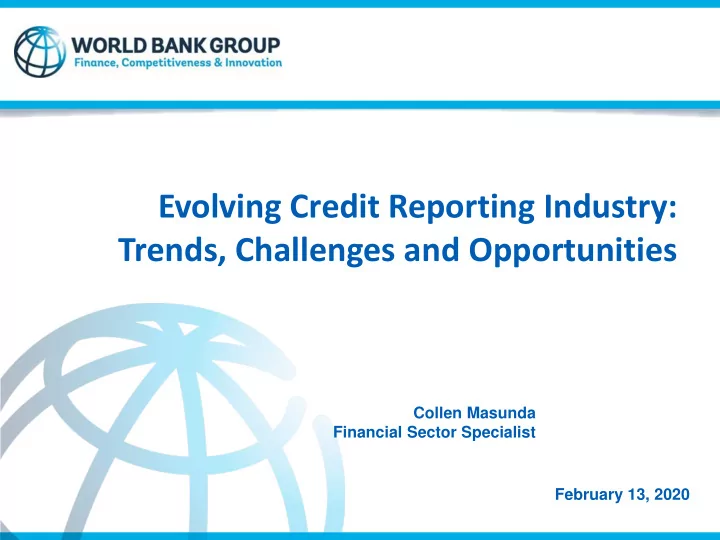

Evolving Credit Reporting Industry: Trends, Challenges and Opportunities Collen Masunda Financial Sector Specialist February 13, 2020
Agenda Credit Reporting 1.0 and 2.0 1 Innovations, Trends and Development 2 Risks, Challenges and Opportunities 3 Implications of the changing landscape 4 5 Future of Credit Reporting: Credit Reporting 3.0? Conclusion 6 2
Credit Reporting History
HISTORY OF CREDIT REPORTING Credit Reporting 2.0 • Small community/ region based • Narrow subscriber base • Hub and Spoke Solutions • user group model • Bureau as a portal • Oligopolistic market • Full file reporting • Negative reporting • Increase in subscribers • Credit scoring and automation of • Entrance of new players workflows • Value added services: Credit Reporting • automated lending solutions • fraud alerts 1.0 4
Innovation, Trends and Developments
Evolving Credit Reporting Landscape Advanced Computing Transaction Platforms Mobile Devices Artificial Intelligence Electronic Payment Psychometric Test Proliferation New System of Big Data Technologies Open Data Systems Social Media New Distributed Ledger Business Technologies (Blockchain) Models Biometrics & National ID Systems Alternative Lenders Alternative Risk Management & Scoring Analytic Companies 6
Risks, Challenges and Opportunities
Risks, Challenges and Opportunities Risks & Challenges Opportunities Incomplete Digitization Data Data Unique Cyber risks of data information privacy security identification sharing Human capital Broad product Cost, Reputational Data Cost capacity offering Competition, risk portability Data and mobility Processing Efficiency Inadequate Data Disintermediation/ legal and protection Exclusion regulatory environment Data Mainstreaming Advance scoring accuracy and of alternative techniques ownership data Financial instability Potential for Consumer discrimination protection 8
IMPLICATIONS OF CHANGING CREDIT REPORTING LANDSCAPE
IMPLICATIONS OF NEW TECHNOLOGIES • Increased reliance on third/ fourth party players heightening cyber risks Advanced /Cloud Computing • Legal and regulatory risks - data residency issues • Bureau system as a services - lower set up and running costs (plug and play models); reduced time of implementing bureau project, • increased competition • Improved data subject identification Biometrics & National Identity Systems • Cross border identification of data subjects – unique global ID ? • Cross border data sharing • Value added products & services – shared eKYC, fraud alerts 10
IMPLICATIONS OF NEW TECHNOLOGIES • Inclusion of thin and/or no file customers Proliferation of Big Data • Data integrity issues • Review of definition of credit data • Expansion in credit reporting ecosystem • Data driven decision making and product & services • Data privacy concerns • Increased data availability • Removes incumbency advantages and opens up the industry (foster competition) Open Data Systems • Data as a public good and not source of competitive advantage • Potential change in data ownership model • Improved product and service innovation 11
IMPLICATIONS OF NEW TECHNOLOGIES • Consumer sovereignty/ permissioned data models / data vaults • Data portability and mobility Distributed Ledger Technologies (Blockchain) • Cross border information sharing • Improved speed and security • Increased appetite for more data easier, faster and more cost effective to mine vast quantities • Artificial Intelligence Improved model power • Irresponsible usage of AI & ML – discrimination • • easier, faster and more effective data transfers APIs • access to more data sources • heightened cyber vulnerability 12
IMPLICATIONS OF NEW PLAYERS • Increased competition: • shrinking margins • product and service innovation • Mergers/ acquisitions/ strategic partnerships • Regulatory arbitrage – regulated vs unregulated players • Potential for instability 13
Future of Credit Reporting
CREDIT REPORTING 3.0 • Bureau as a service • Access on demand model Business - less and less data hosting Model and ownership • More and more data providers: Data • Public Registries Sources • Open data platforms • credit vaults/ passport Products • Core – & Value adds & digital platforms, eKYC, Services fraud, credit passport 15
CONCLUSION • Fundamental model of credit reporting will not change. • Investment in infrastructure and digital foundational stacks important. • Regulatory support is critical. • Localization/ residency rules require a rethink. • Revision of definition of credit data / responsible mainstreaming of alternative data. • Guidance on usage of new technologies and innovations – FEAT Principles on AI. • Human capital development (private and public sector). 16
THANK YOU
Recommend
More recommend